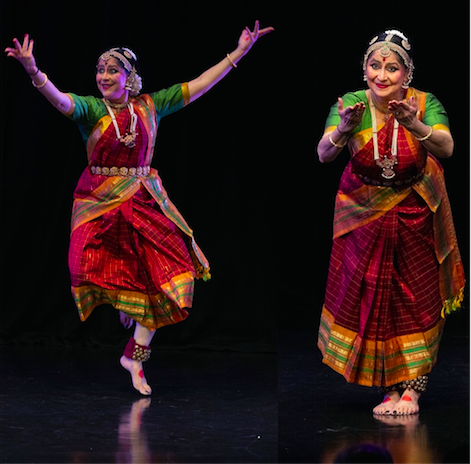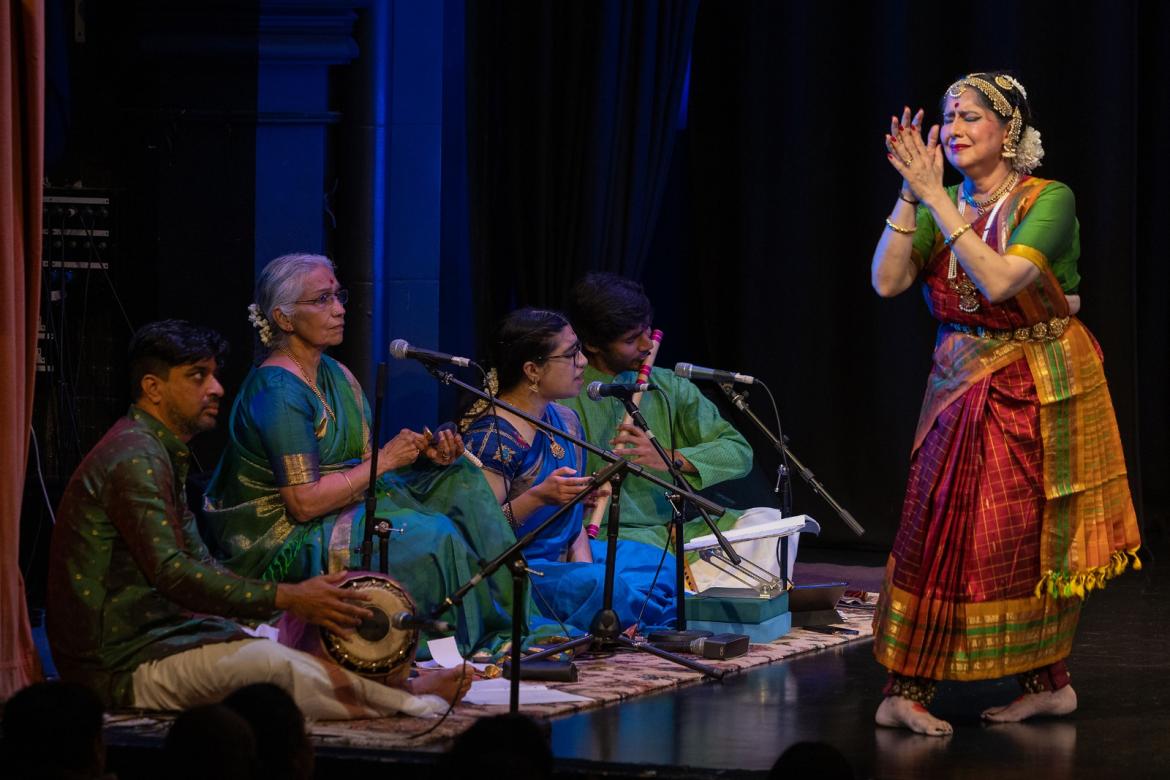Guru samarpanam – Shalini Shivashankar
25 September 2022
Bhavan, London
Reviewed by Annapoorna Kuppuswamy
On a day in late September that felt like a summer afternoon, the South Asian dance world came together post-pandemic for a traditional bharatanatyam performance in the heart of West London. As the appointed hour neared, the buzz was palpable with the great and the good, and the connoisseurs in all their finery, settling in for the much-awaited evening. Shalini Shivashankar, a bharatanatyam and mohiniattam dancer, currently training under Smt Shantha Dhananjayan, was dedicating the evening to her gurus, the Dhananjayans.
After a quick musical salutation to goddess Saraswathi in ragam (melodic scale) Aarabhi, Shalini started the evening with a Ganesha vandanam, warming up for the main item. The centrepiece of the evening, a composition in praise of God Rama sung in ragam Karaharapriya, set to Aadhi thalam (8 beat rhythmic cycle), and the retta kalai (double counts for each beat of rhythmic cycle) set a distinctly slow pace. This centrepiece, which is commonly known as a varnam in a traditional bharatanatyam repertoire, was introduced as a Nrithyopaharam, a term coined by the Dhananjayans to reflect the structure of dance, rather than the musical qualities of the composition. This first half had five long and rhythmically complicated jathis (sequences) that included tisram (cycle of 3), kandam (cycle of 5) and misram (cycle of 7) phrases embedded within the sequences, all composed by Guru Sri Dhananjayan. While the dance choreography for these complicated sequences were cleverly adapted to suit Shalini’s strengths, and she flawlessly maintained the various rhythms, the execution of adavus (fundamental units of bharathanatyam pure dance vocabulary) would have benefitted immensely from more flexibility and strength. The adavus had a ‘placeholder’ feel to them, not fully commanded. However, she exuded quiet confidence and focus that comes with experience, which provided an overall wow factor to the centrepiece.

Image credit: Vipul Sangoi
Shalini, for her exposition of abhinaya (facial expressions), chose the iconic ashtapadi (a composition with eight couplets) Pashyathi, composed by the 12th-century poet Jayadeva. Her intense focus in the piece captured the attention of her audience, and while strong emotions were conveyed, the fundamental undercurrent of the piece was misplaced. Radha’s plight in the absence of Krishna is described by the sakhi (friend), which Shalini, as sakhi, conveyed to Krishna with great bhakti (devotion) and reverence. However, the uniqueness of Jayadeva’s ashtapadis is that Krishna is treated as a mere mortal, with all the desires and flaws of a mortal, and the sakhi, a wise one, who is an equal to Krishna admonishes him for his negligence. Hence, a piece that should have had an undercurrent of romantic annoyance, was rather boringly treated as a bhakti piece.
The second abhinaya composition on Guruvayurappan was an absolute treat. Her desire to portray the piece in exactly the same way as Master (Sri Dhananjayan) was so sincere, that in several sections it felt like one was watching Master perform. The first sight of the child God, full of awe and adoration had the classic hallmarks of kathakali style expressions typical of Master’s abhinaya. The description of the ornamentation, the qualities of Guruvayurappan, and the rituals of puja, brought alive to the audience the pristine beauty of the holy site in Kerala transporting us to a different world.
The performance wrapped up with a short thillana. The use of compositions in four different languages, Tamil, Telugu, Sanskrit and Malayalam was indeed a unique feature of the evening. Needless to say, Guru Shantha Dhananjayan provided excellent nattuvangam support, with all accompanying artists, Sambhavi Udaykumar on vocal, Prathap on mridangam and Shashank on flute, doing a wonderful job. One came away with the satisfaction of watching a wholesome performance that can only be experienced in a traditional bharatanatyam repertoire.




















